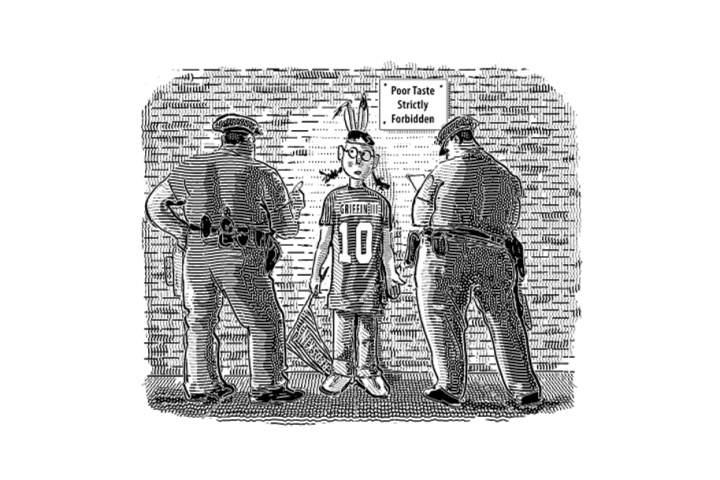Shortly after the 2010 mid-term elections, my old mentor M. Stanton Evans offered his interpretation of the Republican landslide: “The election represents a return of the conservative principles of low taxes, fiscal responsibility, family values, and a strong national defense. In other words—hate.” If anything, this gag is understated—vindicating Evans’s Law of Insufficient Paranoia—which holds that no matter how bad things look, a closer inspection will always find that they’re even worse than you thought.
Earlier this year, campus feminists at Wellesley claimed to feel “assaulted” by a newly installed sculpture of a man in his underwear. At Swarthmore, a student objected to an appearance by Princeton’s Robert P. George (paired with Cornel West), telling the campus paper, “What really bothered me is, the whole idea is that at a liberal arts college, we need to be hearing a diversity of opinion.” Or take the Harvard Crimson editorial writer who argued that the traditional ideal of academic freedom should give way to “academic justice”—which means suppressing any dissenting views, she explained, starting with lonely campus conservative Harvey Mansfield.
The apotheosis of this trend is the current demand for “trigger warnings” of potentially offensive themes and ideas students might encounter in classes or assigned readings. (“Warning: The Great Gastby includes scenes of violence, sexual infidelity, and class exploitation.”) Oberlin College considered but wisely rejected—for now—proposed guidelines for faculty to “Be aware of racism, classism, sexism, heterosexism, cissexism [against transsexual and transgendered persons], ableism, and other issues of privilege and oppression.” Nowadays, questioning animal rights and asserting an intelligible hierarchy of nature—“higher” and “lower” animals—is “speciesism,” though PETA has not (yet) taken to suggesting that cooping chickens is Jim Crow.
The real action at colleges today is around the kaleidescope—or is it collidescope?—of gender enthusiasms. At the left-leaning University of Colorado at Boulder where I taught the past academic year, gay marriage represents the right wing of sexual politics. At least gays and lesbians who wed are imitating a heterosexual practice. Much more startling is the way gender “de-norming” has galloped into prominence, in which it is now presumed that human beings are, or should be, completely free to “choose” their gender, even if they do not avail themselves of surgery and hormone therapy. It’s one thing to decide you might be happier and more personally fulfilled if you switched teams. It’s quite another to say gender is purely a “social construct.” When it comes to human nature, we are now, as Winston Churchill said in another context, “solid for fluidity.”
* * *
At many universities it is now official policy that faculty must formally recognize whatever gender self-identification someone may choose, including something theoretically indeterminate (called “intersex”). Even the gender-defining community is having a hard time keeping up. At Boulder, the standard shorthand is LGBTQ (for Lesbian, Gay, Bi-Sexual, Transgendered, and Queer); at Bowdoin College in Maine, it’s LGBTQIA (adding Intersex and Asexual); while down the road at Bates College it’s LGBTIQQ (the second Q for Questioning).
This spring, after I publicly defended Boulder’s mostly left-leaning philosophy department from a feminist-inspired attack and suggested on Colorado Public Radio that “gender studies” is politicized, two students scoured old writings of mine to find something to give offense. The best they could do was a six-month-old blog post that noted the alphabet soup of “what goes by the LGBTQRSTUW (or whatever letters have been added lately) ‘community.’” The chair of the Faculty Assembly, Professor Paul Chinowsky, promptly declared this off-campus remark to be “bordering on…hate speech” and requiring a formal censure.
Yes, Chinowsky ought to get out more, or perhaps just take in some late night TV. (David Letterman: “Earlier today, President Obama announced that he supports same-sex marriage. [He] also announced a new cabinet position—decorator of the “interior!” But these episodes are about more than free speech or academic freedom. George Orwell’s “two minutes of hate” drill in 1984 has become institutionalized at universities today, where campus culture is suffused with a thoroughly oppressive atmosphere—all in the name of ending oppression.
We’re returning to ’60s-era theories of “repressive tolerance,” which argued sternly for junking free speech and suppressing opposing points of view. As Herbert Marcuse wrote back then, “[T]he restoration of freedom of thought may necessitate new and rigid restrictions on teachings and practices in the educational institutions.” The difference today is that the far Left no longer deigns to dress up its authoritarian streak in any kind of theory. We know what’s right, they insist. So shut up.



